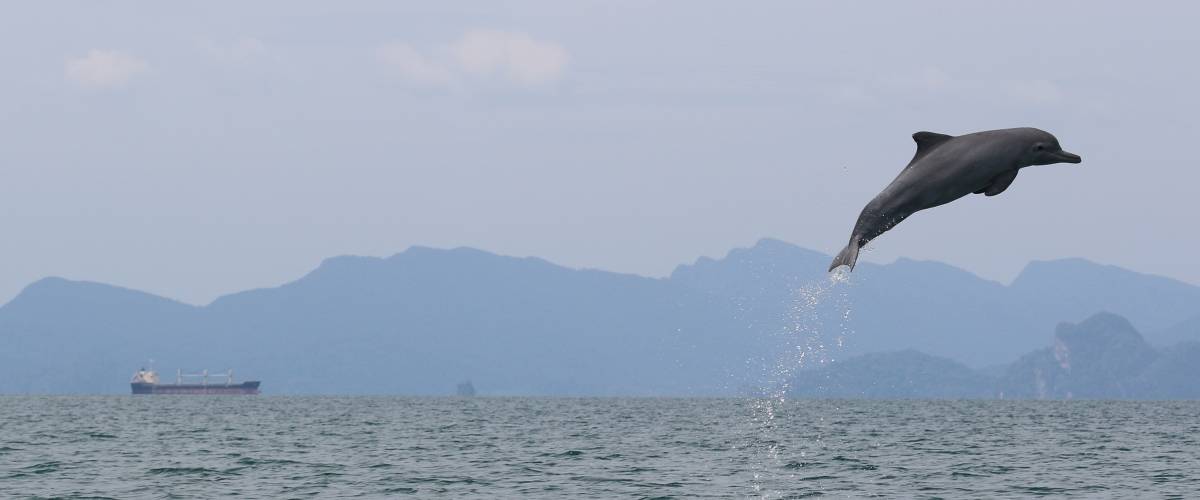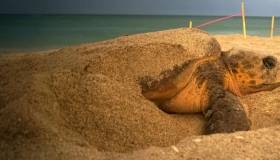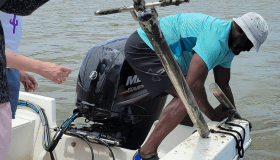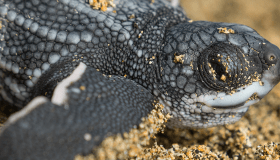
April 8, 2021 – When we hear about pollution affecting wildlife, we often imagine thick plumes of smoke in the air or plastic bottles floating in the ocean. But noise pollution can be just as detrimental to some animals, including marine mammals. Morris Animal Foundation recently funded a study that will assess the impacts of underwater noise on the behavior and stress levels of two locally endangered dolphin species in Malaysia.
The Langkawi archipelago, just off the northwest coast of Malaysia, is arguably one of the biggest tourist destinations in the country. The waters’ surface is full of chugging fishing boats, jet skis racing around and high-speed ferries transporting people between the island and the mainland. In 2019, the International Union for the Conservation of Nature (IUCN) also designated Langkawi’s waters as being part of the Satun-Langkawi Archipelago Important Marine Mammal Area (IMMA).
Among the area’s year-round residents are the Indo-Pacific humpback dolphin, with an almost albino-like appearance, and the Irrawaddy dolphin, with a rounded head and short beak. Because of their proximity to land, both species already are threatened by physical pollution and habitat loss due to degradation from coastal human dwellings and developments, and also are at high risk of entanglement in fishing nets.
The MareCet Research Organization, a nonprofit grassroots organization dedicated solely to research on and conservation of the country’s marine mammals, has studied these dolphins for a decade, mainly through visual observations. But while doing so, Saliza Bono, a MareCet team member, always thought there was more than meets the eye.
“Every time I saw a boat pass by, I wondered what happened acoustically that might affect the dolphins,” said Bono. “Dolphins are very audio-focused animals, in the sense they use a lot of sounds for everyday living. I wondered if these extra sounds were harmful to their well-being.”
She’s worried about sound masking, the covering of one sound by another.
“Imagine going to a club, for example, and you can’t hear your friend talking right next to you because the music is too loud in the background,” she said. “You both have to talk louder or move away from the sound to hear each other.”
For humans, that is an uncomfortable annoyance, but for dolphins, it could be much more problematic. They rely immensely on sounds using whistles, squeaks and echolocation signals such as clicks, to navigate, communicate and forage. That’s why her team started their Morris Animal Foundation-funded study.
“We want to understand if this noise pollution is impacting their vocalizations, making it harder to hear each other or forcing them to use more energy to whistle louder than the engine sounds of passing boats,” said Bono, the study’s primary investigator. “We believe it could be potentially dangerous, making it difficult for them to hunt for food or even separating individuals from their pods.”
This summer, the team will begin a year-long project of evaluating acoustic responses of both dolphin species in two sites within the archipelago and its adjacent waters. Researchers will use a hydrophone (an underwater audio recording device) to track the dolphins’ sounds in relation to nearby boats.
The researchers will analyze the dolphins’ whistles before a boat approaches them, as it passes and after it leaves. Specifically, the team will look at the dolphins’ whistle rates, frequency levels and duration. This information will be used to assess metabolic costs (stress levels) to the animals. The study also will measure how much noise boats produce, as well as boat traffic.
Whistles use a lot of a dolphin’s energy. If a dolphin is forced to whistle louder, longer or more frequently, it could be expending energy needed to search for food. If a dolphin whistles less frequently during these periods, it might be missing out on important opportunities to vocalize or signal danger to the rest of its pod.
In a theoretical worst-case scenario, Bono says mothers might lose contact with their calves or it might become so difficult for some dolphins to find food, they could starve. A real fear is, eventually, the dolphins might just leave. Dr. Louisa Shobhini Ponnampalam, MareCet’s Co-Founder and Executive Director, referenced similar acoustic research on dolphins and whales in other parts of the world.
“There are places they have found where animals have moved out of an area, which they have occupied for many years,” she said. “But maybe it had reached a point that had exceeded the animals’ threshold that they can’t take it anymore and they leave.”
That could have possible implications for humans if it happened in Langkawi. Dolphin watching is one of the nature tourism attractions within the Kilim Geopark Forest in Langkawi. And dolphins like these are indicators of the health of the sea. If they disappear, it would be one less warning sign of low fish resources or environmental changes.
With the information they expect to get, Dr. Ponnampalam would like to work with not only local tour operators, but also her government to push for speed limit zones and some sort of boating code of conduct for boat operators in the region, especially when they are around dolphins.
“I think our results will only strengthen our case of trying to ask the government and everyone to do a little bit more for conservation of the dolphins, as well as of their habitat,” she said. “This benefits everyone if we can all just come together and work to make conservation and habitat management initiatives successful.”
The noise assessment study is the most recent dolphin-related project to receive funding from Morris Animal Foundation. One project studied how dolphin morbillivirus affects different marine mammals. The disease was implicated in a mass die-off of more than 1,500 bottlenose dolphins in the Atlantic region between 2013 and 2015.
Another project developed a technique to assess the body conditions of free-ranging bottlenose dolphins by taking vertical aerial images of animals. The Foundation also provided emergency funding for dolphin studies following the Deepwater Horizon oil disaster in the Gulf of Mexico in 2010.
Learn more about how you can help support research like this. Become a supporting member of Morris Animal Foundation today!




